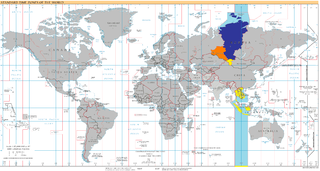Related Research Articles

The Tuvan People's Republic, known as the Tannu Tuva People's Republic until 1926, was a partially recognized socialist republic that existed between 1921 and 1944. The country was located in the same territory as the former Tuvan protectorate of Imperial Russia, known as Uryankhay Krai, north-west of Mongolia, and now corresponds to the Tuva Republic within the Russian Federation.

The Tuvans are a Turkic indigenous people of Siberia who live in Russia (Tuva), Mongolia, and China. They speak Tuvan, a Siberian Turkic language. They are also regarded in Mongolia as one of the Uriankhai peoples.

Tuvan is a Turkic language spoken in the Republic of Tuva in South-Central Siberia in Russia. The language has borrowed a great number of roots from the Mongolian language, Tibetan and the Russian language. There are small diaspora groups of Tuvan people that speak distinct dialects of Tuvan in the People's Republic of China and in Mongolia.

Tannu Uriankhai is a historical region of the Mongol Empire and, later, the Qing dynasty. The realms of Tannu Uriankhai largely correspond to the Tuva Republic of the Russian Federation, neighboring areas in Russia, and a part of the modern state of Mongolia.

Tuva or Tyva, officially the Tyva Republic, is a federal subject of Russia.

UTC+07:00 is an identifier for a time offset from UTC of +07:00. In ISO 8601 the associated time would be written as 2021-12-31T23:48:02+07:00. It is 7 hours ahead of the UTC, meaning areas in this time zone would be 07:00 while UTC is shown to midnight (00:00).

The Dukha, Dukhans or Duhalar are a small Tuvan Turkic community of semi-nomadic reindeer herders living in Khövsgöl, the northernmost province of Mongolia.

Ethmia pyrausta is a moth of the family Depressariidae. It is found in northern Scandinavia and adjacent Russia, as well as in China and Mongolia. The species is sometimes referred to as being "mythical", because it is so rarely encountered outside its remote native range. It is scarce resident in the UK and also found occasionally in other areas in Northern Europe.

The territory currently known as Tuva has been occupied by various groups throughout its history. Sources are rare and unclear for most of Tuva's early history. Archeological evidence indicates a Scythian presence possibly as early as the 9th century BC. Tuva was conquered relatively easily by the succession of empires which swept across the region. It was most likely held by various Turkic khanates until 1207. It was then ruled by Mongols until the 18th century, when it submitted to Manchu rule under the Qing dynasty. Slow Russian colonization during the 19th century led to progressive annexation of the region to Russia in the 20th century. The region was then controlled by the Russian Empire and the Soviet Union before finally joining the Russian Federation in 1992. Throughout this whole time, the borders of Tuva have seen very little modification.
Ethmia cirrhocnemia is a moth in the family Depressariidae. It is found in the southern Ural, the Caucasus, Iran, Turkestan, southern Yenisei, Irkutsk, Mongolia, Transbaikal, China (Mien-shan) and Korea.
Ethmia nigripedella is a moth in the family Depressariidae. It is found in Ukraine, Turkestan, Central Asia, eastern Siberia, Mongolia, northern Tibet, China and Japan.
Ethmia nigrimaculata is a moth in the family Depressariidae. It is found in China (Shansi), Ukraine, Russia and probably Mongolia.
Ethmia septempunctata is a moth in the family Depressariidae. It is found in Japan, Korea, the Russian Far East and China.
Ethmia soljanikovi is a moth in the family Depressariidae. It is found in Mongolia and Russia.
Ethmia comitella is a moth in the family Depressariidae. It is found in Korea, China and Russia.

Oeneis tarpeja is a species of butterfly in the family Nymphalidae. It is found from the Caucasus and Volga region across Kazakhstan and southern Siberia to the Amur region and Mongolia. In Ukraine this species became extirpated in the mid-twentieth century. The habitat consists of steppe-clad plains and foothills.

The Mongolia–Russia border is the international border between Mongolia and the Russian Federation. It runs from west to east between the two tripoints with China for 3,452 km. The boundary is the third longest border between Russia and another country, behind the Kazakhstan–Russia border and the China–Russia border.
Scrobipalpa grisea is a moth of the family Gelechiidae. It is found in Russia, Korea, Mongolia and China.
Ephysteris insulella is a moth in the family Gelechiidae. It was described by Hermann von Heinemann in 1870. It is found in France, Germany, Switzerland, Italy, Bulgaria, Romania and Russia. Outside of Europe, it is found in south-eastern Kazakhstan, southern Siberia, Mongolia and China.

Uryankhay Krai was the name of what is today Tuva and was a short-lived protectorate of the Russian Empire that was proclaimed on 17 April 1914, created from the Urjanchai Republic which had recently proclaimed its independence from the Qing dynasty of China in the Mongolian Revolution of 1911. After the February Revolution and abdication of Tsar Nicholas II, Uryankhay Krai recognized the new Russian Republic and reaffirmed its status as a Russian protectorate in 1917.
References
- ↑ Two new species and two new records of the genus Ethmia Hubner (Lepidoptera: Oecophoridae) from China
- ↑ "Review of Ethmiidae (Lepidoptera) of the Asian part of Russia and neighbouring territories". Archived from the original on 2012-06-30. Retrieved 2012-01-20.